Phones for senior citizens
Probably, many were faced with the need to purchase mobile phones for elderly relatives. The usual solution is to purchase cheap models of a famous (or not) vendor. A few years ago, I first presented my parents with a budget Nokia 1101 and then a more modern, but the same budget Nokia 1112 . Now the situation has changed a bit - specialized phones for the elderly appeared on the market, and before buying another budget device, I decided to look at a couple of similar models.
Both phones that fell into my hands belong to the Just5 line of the Russian-American company Orbita Telecom.
')
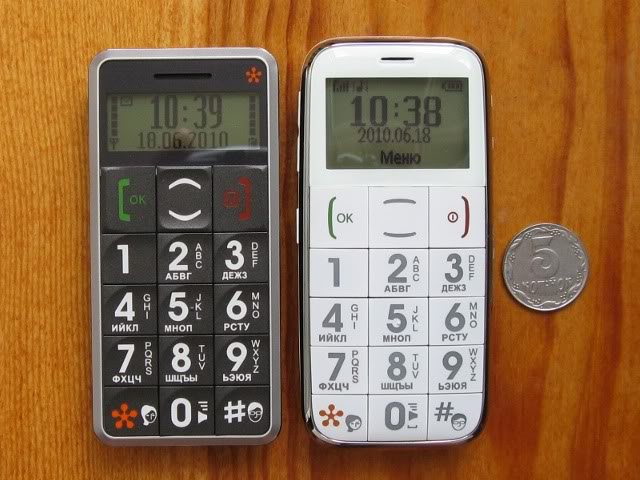
A feature of both devices are the large keys with bright orange backlighting. The large size of the keys (14 mm x 13 mm) allows, on the one hand, to use the phone without any problems for people with impaired motor skills and, on the other, to distinguish large lettering on the keys for people with impaired vision. With all the external similarity of the keys of the devices, the keyboard on the younger model CP09 (in the photo on the left) is more convenient to use due to the relief of the rantik passing through each button. On the older model CP10 (in the photo on the right) there is no such tactile distinction of buttons, which may cause false presses if you miss your finger past the center of the button. The backlight of the keys and the screen are equally good on both phones.
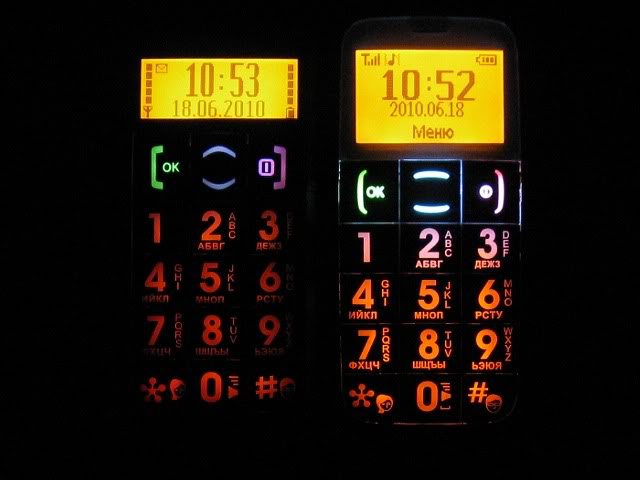
Both devices have four two-position keys, located on the sides of the case, which allow you to quickly activate a particular function. These include locking / unlocking the phone, turning on / off the built-in LED flashlight (no need to say how useful this feature is when moving along our unlit streets and entrances at night), turning on / off the built-in FM radio and adjusting the speaker volume. An interesting feature of the radio is its ability to work without connecting the included headset. In this case, the radio is broadcast via speakerphone. This way of listening to the radio is simpler and more familiar to older people. True, for some unknown reason, the radio button on the CP10 is not sliding but pushing. Interestingly, according to my elderly relative, the side keys are more comfortable on the CP10, again because of the greater relief.
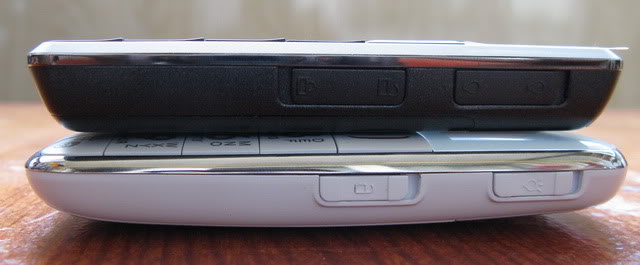

Another difference between the devices is a contrasting bright orange display with a large font in the menu. In CP09, the screen is smaller (39 mm x 15 mm) and contains, as a rule, one line of text, in CP10 it is smaller (37 mm x 23 mm) and there may already be two lines of text. Orange is something like a business card of Just5 phones: even the chargers are made of orange plastic. In addition to the aesthetic, this solution also has a purely practical meaning - it is easier to find orange charging, it is more noticeable in the room (and not only in the room) in the absence of good lighting. I will add that the Just5 chargers are fully compatible with similar devices from Nokia (such as AC-8 with a thin pin).
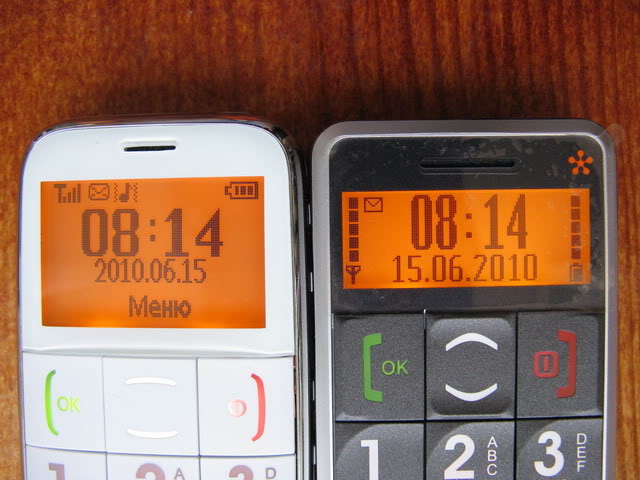
The menu in the devices is called the same - by pressing "up" on the central rocker key (pressing "down" causes the address book). The menu structure of the phones is different - in CP10 it is more logical and resembles the menu of Nokia devices, which is more usual. In CP09, the root menu contains only four items (“CMS”, “Calls”, “Contacts”, “Settings”). This leads to confusion: for example, a calculator and an alarm clock are hidden in the “Settings” menu. Despite the fact that the menu is not that big anymore (you can get to any submenu in 2-3 clicks), it’s quite difficult to understand it right away, especially when only one menu item is visible on the CP09 screen. Unfortunately, the user's manual does not contain maps of menu items or something similar, and future users of the devices (or, at least, the one who gets this device as a gift) will have to study the menu sections independently.
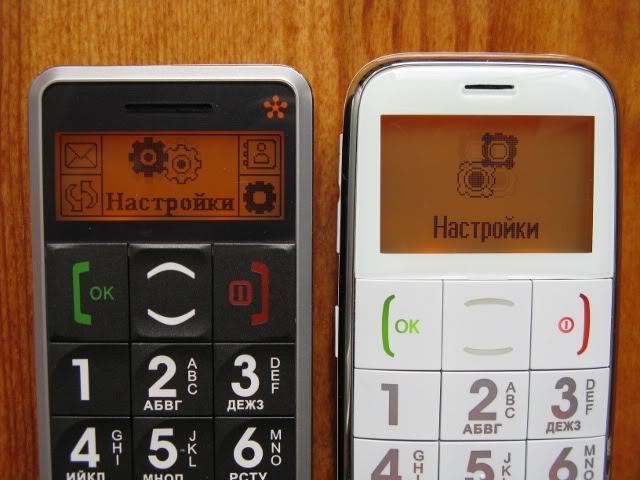
Address book in the devices, as you might guess, is quite simple. Supported operations are standard: add contact, delete, copy, search. Only one phone number can be specified for one subscriber. You can save contacts both in the phone’s memory and on the SIM card. The possibility of speed dialing is very useful, by long pressing one of the phone keys (there can be 10 such “fast” numbers). In addition to the numeric keypad on the front side and the switches on the side, the SOS key is located on the back of the devices. And if the availability of speed dial, flashlight and radio is not something special - all this was to some extent implemented previously in phones from other manufacturers (even budget ones), then the functionality of the SOS button is a distinctive feature of the Just5 devices.
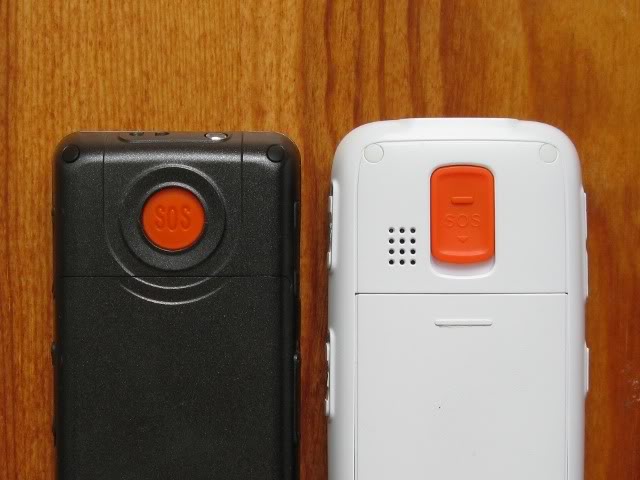
The task of the SOS button is to notify that something happened to the owner of the phone. When you press this key, a consecutive attempt to connect with one of the numbers specified for this occurs (these can be phone numbers of relatives, alarm services, etc.). In parallel with this, a predefined text will be sent to the same numbers. By default, this is “Emergency call, call me!” In addition, after pressing the SOS key, the phone starts to emit loud beeps to attract the attention of others.
Another positive feature of the devices is a good margin of sound level. It can be enhanced for quite comfortable conversation even with a high level of external noise. The same applies to SMS signals. Unfortunately, the vibrating alert is only available on the CP10. In the previous model CP09 in the cold season, when the device is somewhere deep in your pocket, you can skip incoming calls.
Separately, you need to say about battery life. Both models are equipped with a 1000mAh lithium-ion battery. With several calls a day, using a flashlight, navigating through the menu and address book, both devices worked until the batteries were completely discharged for a little more than one week.
To the negative features of the devices, I would refer to the poor ability to configure. For example, only six melodies are available for incoming calls, eight for sms (for some reason, the numbering of the melodies is three-digit). The ability to upload your own melodies and sounds to the devices is missing due to the lack of bluetooth, a data cable for connecting to a PC or something like that. Internet access via wap either. For the same reason, it is not possible to download and launch java midlets. In principle, this is not so bad, because The target audience of the owners of the devices for the most part is not inclined to a similar setup of the devices for themselves, and the devices themselves are originally phones, not smartphones. However, this does not allow, for example, to update the firmware of the phone. Strange, but in the phones only two interface languages are available - this is English and Russian. Probably, the manufacturer plans to distribute devices only in Russia (in any case, these phones are not sold in Ukraine), therefore other languages, for example, from the CIS countries, are absent. The standard calculator application also gives rise to criticism - is it really impossible in the 21st century to make it so that the sign of the operation performed is normally placed between the first and second operands? Here’s what a standard calculator on Android OS looks like.
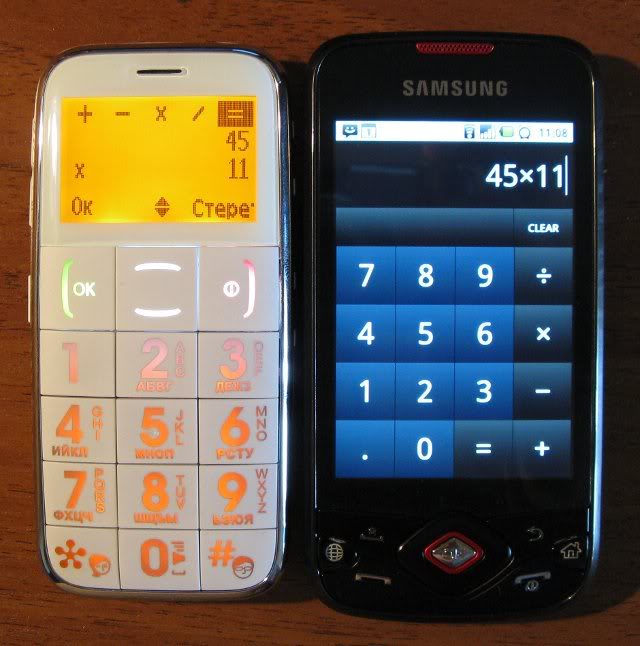
Nevertheless, the progress in the Just5 line is obvious: in addition to the two-line screen, phone profiles appeared in the CP10 model (the following predefined “Normal”, “Meeting”, “Outdoor”, “Indoor”, “Headphones” are available). What in combination with the presence of vibra allows you to flexibly adjust the phone for different situations of use.
So what can be said as a result? Both Just5 models do well with their main function - to provide people with disabilities with mobile communications. And even in spite of some shortcomings (inconvenient side keys in the CP09 model, the absence of a rantik on the CP10 numeric keys, an inconvenient calculator), the development of a number of such niche devices is pleasing (at present, the third model in the Just5 line is already under the CP11 index). Unfortunately, the main drawback of such devices is the price. Thus, the cost of CP09, according to price.ru, is almost $ 100, and the CP10 models are even more expensive - $ 130. And this is despite the fact that the price of budget models of Nokia and Samsung starts now at $ 30. So it turns out that an elderly person can get the device Just5 only as a gift ...
Both phones that fell into my hands belong to the Just5 line of the Russian-American company Orbita Telecom.
')

A feature of both devices are the large keys with bright orange backlighting. The large size of the keys (14 mm x 13 mm) allows, on the one hand, to use the phone without any problems for people with impaired motor skills and, on the other, to distinguish large lettering on the keys for people with impaired vision. With all the external similarity of the keys of the devices, the keyboard on the younger model CP09 (in the photo on the left) is more convenient to use due to the relief of the rantik passing through each button. On the older model CP10 (in the photo on the right) there is no such tactile distinction of buttons, which may cause false presses if you miss your finger past the center of the button. The backlight of the keys and the screen are equally good on both phones.

Both devices have four two-position keys, located on the sides of the case, which allow you to quickly activate a particular function. These include locking / unlocking the phone, turning on / off the built-in LED flashlight (no need to say how useful this feature is when moving along our unlit streets and entrances at night), turning on / off the built-in FM radio and adjusting the speaker volume. An interesting feature of the radio is its ability to work without connecting the included headset. In this case, the radio is broadcast via speakerphone. This way of listening to the radio is simpler and more familiar to older people. True, for some unknown reason, the radio button on the CP10 is not sliding but pushing. Interestingly, according to my elderly relative, the side keys are more comfortable on the CP10, again because of the greater relief.


Another difference between the devices is a contrasting bright orange display with a large font in the menu. In CP09, the screen is smaller (39 mm x 15 mm) and contains, as a rule, one line of text, in CP10 it is smaller (37 mm x 23 mm) and there may already be two lines of text. Orange is something like a business card of Just5 phones: even the chargers are made of orange plastic. In addition to the aesthetic, this solution also has a purely practical meaning - it is easier to find orange charging, it is more noticeable in the room (and not only in the room) in the absence of good lighting. I will add that the Just5 chargers are fully compatible with similar devices from Nokia (such as AC-8 with a thin pin).

The menu in the devices is called the same - by pressing "up" on the central rocker key (pressing "down" causes the address book). The menu structure of the phones is different - in CP10 it is more logical and resembles the menu of Nokia devices, which is more usual. In CP09, the root menu contains only four items (“CMS”, “Calls”, “Contacts”, “Settings”). This leads to confusion: for example, a calculator and an alarm clock are hidden in the “Settings” menu. Despite the fact that the menu is not that big anymore (you can get to any submenu in 2-3 clicks), it’s quite difficult to understand it right away, especially when only one menu item is visible on the CP09 screen. Unfortunately, the user's manual does not contain maps of menu items or something similar, and future users of the devices (or, at least, the one who gets this device as a gift) will have to study the menu sections independently.

Address book in the devices, as you might guess, is quite simple. Supported operations are standard: add contact, delete, copy, search. Only one phone number can be specified for one subscriber. You can save contacts both in the phone’s memory and on the SIM card. The possibility of speed dialing is very useful, by long pressing one of the phone keys (there can be 10 such “fast” numbers). In addition to the numeric keypad on the front side and the switches on the side, the SOS key is located on the back of the devices. And if the availability of speed dial, flashlight and radio is not something special - all this was to some extent implemented previously in phones from other manufacturers (even budget ones), then the functionality of the SOS button is a distinctive feature of the Just5 devices.

The task of the SOS button is to notify that something happened to the owner of the phone. When you press this key, a consecutive attempt to connect with one of the numbers specified for this occurs (these can be phone numbers of relatives, alarm services, etc.). In parallel with this, a predefined text will be sent to the same numbers. By default, this is “Emergency call, call me!” In addition, after pressing the SOS key, the phone starts to emit loud beeps to attract the attention of others.
Another positive feature of the devices is a good margin of sound level. It can be enhanced for quite comfortable conversation even with a high level of external noise. The same applies to SMS signals. Unfortunately, the vibrating alert is only available on the CP10. In the previous model CP09 in the cold season, when the device is somewhere deep in your pocket, you can skip incoming calls.
Separately, you need to say about battery life. Both models are equipped with a 1000mAh lithium-ion battery. With several calls a day, using a flashlight, navigating through the menu and address book, both devices worked until the batteries were completely discharged for a little more than one week.
To the negative features of the devices, I would refer to the poor ability to configure. For example, only six melodies are available for incoming calls, eight for sms (for some reason, the numbering of the melodies is three-digit). The ability to upload your own melodies and sounds to the devices is missing due to the lack of bluetooth, a data cable for connecting to a PC or something like that. Internet access via wap either. For the same reason, it is not possible to download and launch java midlets. In principle, this is not so bad, because The target audience of the owners of the devices for the most part is not inclined to a similar setup of the devices for themselves, and the devices themselves are originally phones, not smartphones. However, this does not allow, for example, to update the firmware of the phone. Strange, but in the phones only two interface languages are available - this is English and Russian. Probably, the manufacturer plans to distribute devices only in Russia (in any case, these phones are not sold in Ukraine), therefore other languages, for example, from the CIS countries, are absent. The standard calculator application also gives rise to criticism - is it really impossible in the 21st century to make it so that the sign of the operation performed is normally placed between the first and second operands? Here’s what a standard calculator on Android OS looks like.

Nevertheless, the progress in the Just5 line is obvious: in addition to the two-line screen, phone profiles appeared in the CP10 model (the following predefined “Normal”, “Meeting”, “Outdoor”, “Indoor”, “Headphones” are available). What in combination with the presence of vibra allows you to flexibly adjust the phone for different situations of use.
So what can be said as a result? Both Just5 models do well with their main function - to provide people with disabilities with mobile communications. And even in spite of some shortcomings (inconvenient side keys in the CP09 model, the absence of a rantik on the CP10 numeric keys, an inconvenient calculator), the development of a number of such niche devices is pleasing (at present, the third model in the Just5 line is already under the CP11 index). Unfortunately, the main drawback of such devices is the price. Thus, the cost of CP09, according to price.ru, is almost $ 100, and the CP10 models are even more expensive - $ 130. And this is despite the fact that the price of budget models of Nokia and Samsung starts now at $ 30. So it turns out that an elderly person can get the device Just5 only as a gift ...
Source: https://habr.com/ru/post/97045/
All Articles